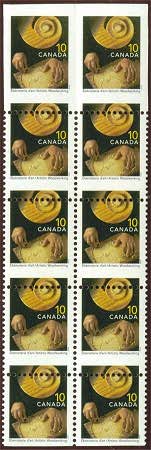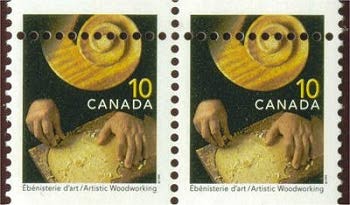
 |
Canadian Post Office Visit Yields Bonanza,
Starts Treasure Hunt
by David Stein, Montreal
 When I purchased some stamps on Friday July 18th little did I know that this would mark my return to a long dormant pastime. As an active stamp collector in my youth I founded The McGill Stamp Club in the 1970's. In 1971 we mounted a philatelic exhibition to commemorate the 150th anniversary of the founding of McGill University. It was a great success with a special McGill 150th envelope and Canada Post cancellation. However, as frequently happens in life, marriage, children and other obligations diminished my resources in both time and money for my hobby.
When I purchased some stamps on Friday July 18th little did I know that this would mark my return to a long dormant pastime. As an active stamp collector in my youth I founded The McGill Stamp Club in the 1970's. In 1971 we mounted a philatelic exhibition to commemorate the 150th anniversary of the founding of McGill University. It was a great success with a special McGill 150th envelope and Canada Post cancellation. However, as frequently happens in life, marriage, children and other obligations diminished my resources in both time and money for my hobby. Fast forward to July 2003, when I needed some various low-value stamps for postage. I required these stamps to make up the current 48¢ first class postage rate with some older stamps.
Among the stamps purchased were several blocks of ten 5-, 10-, and 25-cent stamps. They were part of the "Traditional Trades" series issued in 1999. When I returned home it did not take long for me to realize that the perforations on the 10-cent woodworking stamps were offset by 4.5 millimeters. In fact the perforation shift was so large that the top two stamps (of the block of ten) were completely imperforate! I returned to the local postal outlet and brought home the remaining stamps in the bin.
The postal clerks had not realized the significance of the error and had divided the sheet of 100 stamps in ten blocks of ten stamps for their retail bin. They trimmed the stamps by cutting through the middle of each stamp. Thus the only way to obtain an "imperforate pair" is to obtain a block of four attached stamps. The error has been submitted to Scott's and they will probably be listed as both a single imperforate and a block of four.
Errors in Canadian stamps have occurred with increasing frequency over the last few years. Some have commented over backdoor errors that seem to have popped up from certain printers.
However, this is the only recorded error in the Traditional Trades series since they were issued in 1999. Since these stamps were actually sold at a postal outlet they are considered a real error, rather then a manufactured one.
These stamps were printed at the Canadian Bank Note Company. (Canada Post told the National Post newspaper that they came from Ashton-Potter, but I have determined otherwise.) The error was probably created when a single print sheet of stamps was removed for inspection during the print run. The sheet that contained four to six panes of 100 stamps was not properly replaced and passed through the perforating machine. Quality control did not pick up the error and at least two panes made it to the post office.
 The stamps were featured in two recent stories in both Linn's and The Canadian Stamp News. These stamps were sold for some time before I made my discovery. Many have probably been used in regular postage and may be found over the next few months. It has started somewhat of a treasure hunt, so much so that one of Canada's mass circulation national newspapers, The National Post, published a feature article about the discovery on August 14th.
The stamps were featured in two recent stories in both Linn's and The Canadian Stamp News. These stamps were sold for some time before I made my discovery. Many have probably been used in regular postage and may be found over the next few months. It has started somewhat of a treasure hunt, so much so that one of Canada's mass circulation national newspapers, The National Post, published a feature article about the discovery on August 14th. I have been in contact with several specialist dealers concerning this discovery. I have received many suggestions but for now I have decided to put the five blocks of ten stamps (each with two imperfs) away until they get officially listed. I also have several blocks of ten stamps from the bottom half of the panes that contain only the perforation shifts.
Finally I was able to obtain one block of nine stamps in which one of the imperfs was sold. I welcome any suggestions from the readers of this column.
In the meantime my life has changed as the hunt goes on. I have even drafted my sons to help search for more of them throughout the Montreal area. Maybe one of the readers of this story will be so lucky.